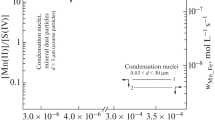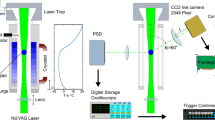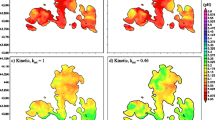Abstract
For the purpose of testing our previously described theory of SO2 scavenging a laboratory investigation was carried out in the UCLA 33 m long rainshaft. Drops with radii between 250 and 2500 μm were allowed to come to terminal velocity, after which they passed through a chamber of variable length filled with various SO2 concentrations in air. After falling through a gas separating chamber consisting of a fluorocarbon gas the drops were collected and analyzed for their total S content in order to determine the rate of SO 2 absorption.
The SO2 concentration in air studied ranged between 1 and 60% (v). Such relatively large concentrations were necessary due to the short times the drops were exposed to SO2 in the present setup. The present experimental results were therefore not used to simulate atmospheric conditions but rather to test our previously derived theory which is applicable to any laboratory or atmospheric condition. Comparison of our studies with the results from our theory applied to our laboratory conditions led to predicted values for the S concentration in the drops which agreed well with those observed if the drops had radii smaller than 500 μm. In order to obtain agreement between predicted and observed S concentrations in larger drops, an empirically derived eddy diffusivity for SO2 in water had to be included in the theory to take into account the effect of turbulent mixing inside such large drops.
In a subsequent set of experiments, drops initially saturated with S (IV) were allowed to fall through S-free air to determine the rate of SO 2 desorption. The results of these studies also agreed well with the results of our theoretical model, thus justifying the reversibility assumption made in our theoretical models.
In a final set of experiments, the effects of oxidation on SO2 absorption was studied by means of drops containing various amounts of H2O2. For comparable exposure times to SO2, the S concentration in drops with H2O2 was found to be up to 10 times higher than the concentration in drops in which no oxidation occurred.
Similar content being viewed by others
References
Abbot C. E. and Cannon T., 1972, A droplet generator with electronical control of size, production rate and charge, Rev. Sci. Instr. 43, 1313–1317.
Altwicker A. and Chapman C., 1981, Mass transfer of SO2 into falling drops: A comparison with absorption models, Atmos. Environ. 15, 297–300.
Barrie L. A. and Georgii H. W., 1976, An experimental investigation of the absorption of SO2 by water drops containing heavy metal ions, Atmos. Environ. 10, 743–749.
Beard K. V. and Pruppacher H. R., 1971, A wind tunnel investigation of the rates of evaporation of water drops falling at terminal velocity in air, J. Atmos. Sci. 28, 1455–1464.
Beilke S., 1970, Laboratory investigations on washout of trace gases, Precipitation 1970, Nat. Techn. Info. Serv. U.S. Dept. of Commerce, Springfield, Va. 22151 (available as CONF-700601).
Beilke S. and Georgii H. W., 1968, Investigation in the incorporation of SO2 into fog and rain drops, Tellus 20, 435–442.
Garner F. H. and Lane J. J., 1959, Mass transfer to drops of liquid suspended in a gas stream, Trans. Inst. Chem. Engr. 37, 162–172.
Martin L. R. and Damschen D. E., 1981, Aqueous oxidation of sulfur dioxide by hydrogen peroxide at low pH, Atmos. Environ. 15, 1615–1621.
Pruppacher H. R., and Klett J. D., 1978, Microphysics of Clouds and Precipitation, D. Reidel, Dordrecht, p. 214.
Sillen, L. G., 1964, Stability constants of metal ion complexes, Section-1: Inorganic ligands, Chem. Soc. (London), Spec. Publ. No. 17, p. 754.
Walcek C. J., Wang P. K., Topalian J. H., Mitra S. K., and Pruppacher H. R., 1981, An experimental test of a theoretical model to determine the rate at which freely falling water drops scavenge SO2 in air, J. Atmos. Sci. 38, 871–876.
Walcek C. J. and Pruppacher H. R., 1984, On the scavenging of SO2 by cloud and rain drops. I: A theoretical study of SO2 absorption and desorption for water drops in air. J. Atmos. Chem. 1, 269–289.
Wang P. K. and Pruppacher H. R., 1977, Acceleration to terminal velocity of cloud and rain drops. J. Appl. Meteorol. 16, 275–280.
Author information
Authors and Affiliations
Rights and permissions
About this article
Cite this article
Walcek, C.J., Pruppacher, H.R., Topalian, J.H. et al. On the scavenging of SO2 by cloud and raindrops: II. An experimental study of SO2 absorption and desorption for water drops in air. J Atmos Chem 1, 291–306 (1983). https://doi.org/10.1007/BF00058733
Received:
Revised:
Issue Date:
DOI: https://doi.org/10.1007/BF00058733




